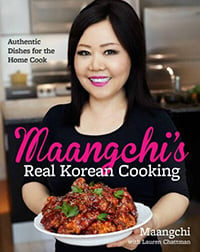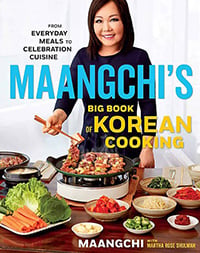Today I’m going to show you how to make bukkumi, pan fried rice cakes filled with sweet red beans, or with mung bean paste. These rice cakes are gooey, chewy, and sweet on the inside and crispy on the outside. The texture is just wonderful, both soft and crispy at the same time.
The best thing about these is that they are very quick to make. With a box of glutinous rice flour and a can of sweet red beans, you can make them in 10 minutes! If a Korean grocery store is far away from your home, you can buy these ingredients on Amazon, or you can make your own sweet red bean paste, or use the mung bean paste that I show you in this recipe.
When I lived in Korea, these were a lot harder to make because they didn’t sell glutinous rice flour in a box. You had to bring your soaked and strained chapssal (glutinous rice) to the local mill and have them grind it into flour for you. So it’s a real treat for me to be able to make them so easily these days.
If you like to make bukkumi and save some for later, you can freeze them up to one month. To serve them, reheat in the microwave or in a pan with a bit of oil.
I love the cute name of this dish! Let me know how yours turn out!
Ingredients
Makes 4 bukkumi
For mung bean filling
- ½ cup dried skinned mung beans, rinsed and soaked for 2 hours
- a pinch of kosher salt
- 2-3 tablespoons sugar or honey
For red bean filling
- A can of sweet red beans, or make your own from my patbingsu recipe
For the rice cake dough
- 1 cup glutinous rice flour (Mochiko)
- ⅓ cup plus 2 tablespoons hot boiling water
- ¼ teaspoon kosher salt
- About 2-3 tablespoons extra rice flour for dusting
For garnish
- 1 jujube, the seed removed, rolled and cut into thin slices
- 8 pumpkin seeds
- 1 tablespoon honey
For pan frying
- Cooking oil (grape seed oil, corn oil, or vegetable oil)
- toasted sesame oil
Directions
Make sweet mung bean paste (if using)
- Strain the beans and put them into a heavy pot. Add ⅓ cup water and a pinch of salt. Cover and cook for 10 minutes over medium heat. Keep an eye on them to see if a lot of bubbles form. If so, open the lid and stir the beans with a wooden spoon. Cover and keep cooking.


- Turn down the the heat to very low and simmer for another 5 minutes.
- Remove from the heat and mash the beans with a wooden spoon until they form a smooth, soft, shapeable dough. Add the honey and mix well.

- You can make 8 to 10 bukkumi with this amount of mung bean paste. Take 2 to 3 tablespoons of the paste and and roll it between the palms of your hands to shape it into a little football. Roll all the paste into footballs and set aside.
Make the dough
- Combine the rice flour, kosher salt, and hot water in a mixing bowl. Mix with a wooden spoon until it cools down, and knead the dough with your hand for 1 minute until it turns into a lump. Wrap it in plastic wrap and let it sit.
- 5 to 10 minutes later, knead it again on the cutting board until it turns smooth, for about 2 minutes. Use some extra rice flour to dust the cutting board so the dough doesn’t stick to it.

- Divide the dough into 4 equal pieces. Roll each piece between your hands, into a ball.

- Put each ball onto the cutting board one by one and roll them out to about 5½ inch disks.


Make bukkumi
- Heat up a non-stick pan over medium heat. Add about 1 tablespoon cooking oil and 1/2 teaspoon of toasted sesame oil. Swirl the pan to mix the oil evenly.
- Put one of the dough disks on the pan and cook for 30 to 40 seconds until the edges start cooking and it looks a little translucent.
- Flip it over and add one of the mung bean paste balls to the center of it. If you’re using canned sweet red bean paste, scoop about 2 to 3 tablespoons worth into the center.

- Fold the disk over with your spatula to make a half moon. Press the edge slightly and let it cook for 1 minute. Turn it over and cook until both sides are a little crunchy, but not browned.

- Repeat with the rest of the disks and bean paste.
Serve
Garnish with jujube and pumpkin seeds, and serve as a dessert or snack with coffee or tea.

Maangchi's Amazon picks for this recipe
It's always best to buy Korean items at your local Korean grocery store, but I know that's not always possible so I chose these products on Amazon that are good quality. See more about how these items were chosen.














![[OTTOGI] Premium Roasted Sesam...](https://m.media-amazon.com/images/I/41DixbNS9AL._SL160_.jpg)

























Maangchi,
I was thinking about what you wrote. How people in Korea used to take “soaked strained chapssal” to be ground. So, soaking was part of the tradition, right? This would reduce the phytic acid (and probably change other things), making the nutrients in the rice more bioavailable. I think rice flour is just ground up rice, right? Then the phytic acid remains, reducing the nutrients available to the body.
Do you know how long people used to soak the rice grains? Do you know if there was any fermentation of the rice prior to draining and grinding? ‘
I have been wondering if changing cooking methods and ingredients (convenient flour, instead of soaking first) has reduced nutrients in cooking. In the US, many people got rickets and other diseases when flour was made available in the 1920s. That is why synthetic vitamin B, etc, is added to flour now. But it isn’t the same.
I just got Koda farms organic glutinous rice at Housework. It’s delicious. I am going to try soaking and grinding (maybe with my hand blender).
LOVE LOVE your recipes!!!!! I couldn’t remember many names of foods I loved when my Dad (Korean) made them because he passed away many years ago. So I am super happy you decided to make this site. I bought all your books, even the old ones (some real gems in those first books!!)
I really enjoyed this crunchy and chewy snack that made me giggle while making them. It’s very satisfying when you’ve done something that makes you feel like a child again^^_^^
See full size image
Hello Maangchi,
Here I am stalking your blog and dreaming eating the same samgyetang I ate during my previous visit to Korea. I stumble upon your recipe and wondering how here in Malaysia, we have the same dessert as ‘bukkumi’. the method were almost the same glutinous rice flour and hot water and this ingredients combine together…. shredded fresh coconut flesh, a pinch of salt and a tablespoon of cooking oil. make a dough. after that you ball it up for bite size, press it using your palm and fry in hot oil. you can eat as it is or.. in the skillet bring water to boil and add sugar. let the sugar water boil down and put in the fried dough… toss until all the surface coated with sugar… yummmm… I hope I can show you a picture…
P/s: by the way I love those ribbons… cute…
Thank you for sharing your Malaysian version of fried rice cake. It sounds very delicious!
bapgongju
I like them with all kinds of filling. You could try chestnut paste or lotus seed paste too. I was not too thrilled with red bean paste either until i tried one that was made very smooth like the filling of a sesame ball. This is done by straining the bean husks, adding some oil and a little more cooking.
Some types of custard might even be tasty.
As a Korean, I’m ashamed to admit I strongly dislike red bean paste and mung bean paste. My grandmother and dad were always so kind to let me eat the dduk while they ate the filling. So if I was to swap the paste for cooked fruit or even jam, do you think it would work?
Is there a reason for why you make the half moon after you start cooking these cakes? Wouldn’t it be easier to fold them in half before cooking first?
Thank You!
Yes, you can add anything you want. Why not! : ) I just want to show an authentic recipe. Some people don’t like sweet red bean paste and some people love it. Me? I love it!
thank you for the recipe maangchi! but how about 수수부꾸미? how do i make the dough pinky like that?
Mix glutinous sorghum powder and glutinous rice flour to make one cup and follow the recipe.
네! 알겠습니다! 감사합니다!
그런데 glutinous sorghum powder는 한국말로 어떻게 돼세요? 지금 서울에 살고 있는데…감사합니다!
찹쌀 기장?
Bye, Sanne.
Glutinous sorghum powder is “찰수수가루” in Korean.